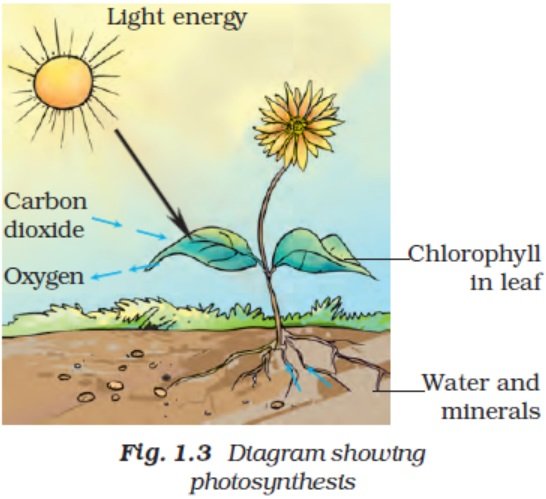NCERT Solutions Class 7 Science
The NCERT Solutions in English Language for Class 7 Science Chapter – 1 (Nutrition in Plants) has been provided here to help the students in solving the questions from this exercise.
Chapter – 1 (Nutrition in Plants)
1. Why do organisms take food?
Answer – The organisms need to take food to build their bodies, to grow, to repair damaged part of their bodies and to obtain the energy to carry out life processes. Food provide resistance to fight against diseases and protection from different infections.
2. Distinguish between a parasite and a saprophyte.
Answer –
| Saprophytes | Parasites |
| Acquire nutrients from dead and decaying matter | Parasites live on or in a host and get its food at the expense of its host |
| Example – Fungi, Mushrooms | Example – Roundworm, Cuscuta |
3. How would you test the presence of starch in leaves?
Answer – The presence of starch in leaves can be tested by Iodine test. When we remove chlorophyll from leaf by boiling it in alcohol and then put 2 drops of iodine solution, its colour change to blue indicates the presence of starch.
4. Give a brief description of the process of synthesis of food in green plants
Answer – The green plants have chlorophyll in the leaves. The leaves use C02 and water to make food in presence of sunlight.

5. Show with the help of a sketch that plants are the ultimate source of food.
Answer –

6. Fill in the blanks:
(a) Green plants are called _________________ since they synthesise their own food.
(b) The food synthesised by plants is stored as _________________.
(c) In photosynthesis solar energy is absorbed by the pigment called ___________.
(d) During photosynthesis plants take in ______________________ and release __________________ gas.
Answer –
(a) Green plants are called autotrophs since they synthesise their food.
(b) The food synthesised by plants is stored as starch.
(c) In photosynthesis, solar energy is absorbed by the pigment called chlorophyll.
(d) During photosynthesis, plants take in carbon dioxide and release oxygen gas.
7. Name the following:
(i) A parasitic plant with yellow, slender and branched stem.
(ii) A plant that is partially autotrophic.
(iii) The pores through which leaves exchange gases.
Answer –
(i) A parasitic plant with yellow, slender and branched stem. – Cuscuta
(ii) A plant that is partially autotrophic. – Pitcher plant
(iii) The pores through which leaves exchange gases. – Stomata
8. Tick the correct answer:
(a) Cuscuta is an example of:
(i) autotroph (ii) parasite (iii) saprotroph (iv) host
(b) The plant which traps and feeds on insects is:
(i) Cuscuta (ii) china rose (iii) pitcher plant (iv) rose
Answer –
(a) Cuscuta is an example of : – (ii) Parasite
(b) The plant which traps and feeds on insects is : – (iii) pitcher plant
9. Match the items given in Column I with those in Column II:
| Column- I | Column-II |
| Chlorophyll | Rhizobium |
| Nitrogen | Heterotrophs |
| Cuscuta | Pitcher plant |
| Animals | Leaf |
| Insects | Parasite |
Answer –
| Column- I | Column-II |
| Chlorophyll | Leaf |
| Nitrogen | Rhizobium |
| Cuscuta | Parasite |
| Animals | Heterotrophs |
| Insects | Pitcher plant |
10. Mark ‘T’ if the statement is true and ‘F’ if it is false:
(i) Carbon dioxide is released during photosynthesis. (T/F)
(ii) Plants which synthesise their food are called saprotrophs. (T/F)
(iii) The product of photosynthesis is not a protein. (T/F)
(iv) Solar energy is converted into chemical energy during photosynthesis. (T/F)
Answer –
(i) Carbon dioxide is released during photosynthesis. (False)
(ii) Plants which synthesise their food are called saprotrophs. (False)
(iii) The product of photosynthesis is not a protein. (True)
(iv) Solar energy is converted into chemical energy during photosynthesis. (True)
11. Choose the correct option from the following:
Which part of the plant takes in carbon dioxide from the air for photosynthesis?
(i) Root hair (ii) Stomata (iii) Leaf veins (iv) Petals
Answer – (ii) Stomata
12. Choose the correct option from the following:
Plants take carbon dioxide from the atmosphere mainly through their:
(i) roots (ii) stem (iii) flowers (iv) leaves
Answer – (iv) leaves
13. Why do farmers grow many fruits and vegetable crops inside large greenhouses? What are the advantages to the farmers?
Answer – Fruits and vegetable crops are grown in large greenhouses because it protects crops from external climatic condition and to provide suitable temperature for the growth of crops.
Advantages to farmers while growing fruits and vegetable crops inside greenhouses are
- It protects crops from diseases and adverse climatic conditions.
- It protects crops from wind and rodents.
- Farmers have bountiful crops.
- Farmer’s crops are also protected from birds and animals.

